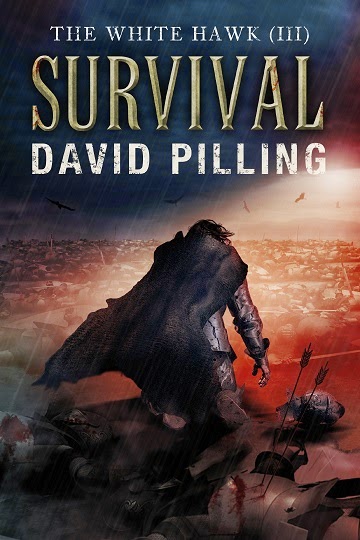Among the desolate flats of the Western Province, a particularly bleak region of the Winter Realm, rises a single spire of rock. This lone mountain is known as Mount Silverback, after the permanent caps of white ice gleaming on its lofty heights.
Seen from the plains below, it looks like a castle of sorts built into the side of the mountain. Seven round towers are visible near the summit, built on a series of uneven precipices linked by steep wooden staircases and paths hacked out of the rock. From the highest peak flies a great banner, rippling forever in the freezing winds that sweep across the plains and buffet the mountain. The banner displays a black sword against a stark white field, symbol of the priest-knights that dwell inside Silverback.
This is the outward face of the Temple of Occido, a grim warrior-cult dedicated to the worship of Occido, the God of War. The Templars that reside in this remote and inhospitable spot chose it for precisely those qualities. Here, far away from the other settlements of the Winter Realm, they are free to commune with their savage deity and pursue their secretive, ritualised existence.
The Templars play an important role in The Best Weapon, the first of the epic fantasy novels I am co-writing with Martin Bolton. One of the central characters, Fulk the No-Man's Son, was adopted by the Templars as an orphan, and raised to follow their grim code and grimmer religion. He is privy to some - not all - of their secrets, and knows what many outsiders don't: the core of Mount Silverback is essentially hollow, with hundreds of halls and winding passages carved out of the living rock by long-dead hands.
The first Templars discovered these deep chambers, bare and apparently deserted, when they first came to explore Silverback. They wasted no time in occupying the place, and in hiding or rubbing out the peculiar symbols and diagrams carved onto the walls. The existence of these, as well as certain passages that led down down into unexplored catacombs deep under the mountain, were carefully hushed up. So far as the knights of Occido are concerned, what they don't know (probably) won't hurt them.
I took my inspiration for the Temple, and its reclusive inhabitants, from various cells of my fractured mind. The Temple itself, perched on a high mountain far away from the rest of civilisation, was inspired by dramatic images of Buddhist temples in Nepal and Tibet, such as the one to the right.
Occido, the belligerent God of War, was inspired by Mars, the Roman God of War, though he has a slightly cruder, more shamanic quality. The Templars envisage him as a gigantic warrior, clad in armour of steaming, red-hot iron, faceless behind the stern visage of his helm. All that can be seen of his face is a pair of red eyes that glow like twin fires. As befits a god of war, Occido is pitiless, heartless, and entirely fixated on death and slaughter and military glory. These are the things prized by the Templars, making them a fairly joyless bunch to deal with, though very good at fighting.
The Templars themselves are obviously inspired by the historical Templars, though unlike their real-life counterparts they play little to no part in politics, and do not allow themselves to become corrupted or softened by worldly riches. Hidden away on their mountain, reliant on mysterious resources to survive, they resemble the inmates of a prison who have chosen not to escape.
Still, this brotherhood of strange and rather unpleasant men - they are almost all men - have played an important part in the history of the Winter Realm, and are fated to do so again in The Best Weapon and its sequels. The black sword of the Temple will once again fly over stricken battlefields, and the war-shout of the knights of Occido will cause the enemies of the realm to quake in their boots...







